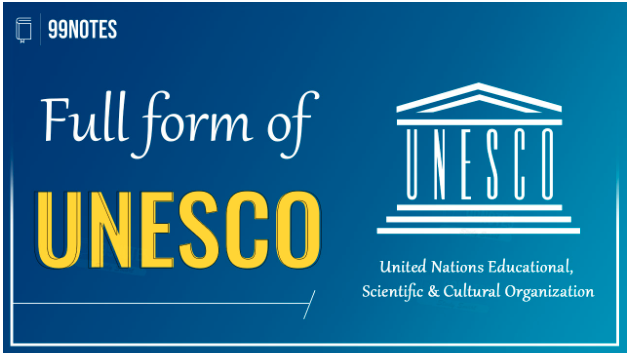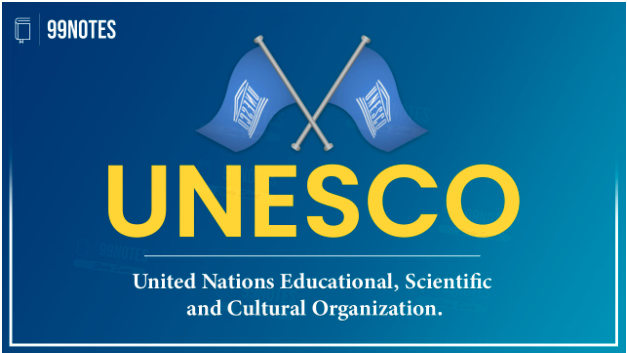UNESCO Full Form: History, Objectives, Programm, India & UNESCO
What is the full form of UNESCO?

The full form of UNESCO is “United Nations Educational, Scientific and Cultural Organisation”. It is a vital programme run by the United Nations. UNESCO is a United Nations specialized agency that promotes world peace through global cooperation in the fields of education, culture and science.
What is UNESCO?
The United Nations Educational, scientific and cultural organizations (UNESCO) is a United Nations specialized organization. It aims to promote peace via worldwide collaboration in education, science, and culture.
It is also a member of the United Nations Sustainable Development Group (UNSDG), a coalition of UN agencies and organizations dedicated to achieving the Sustainable Development Goals.
- The headquarters of UNESCO is in Paris, and the organization has over 50 branch offices across the world.
- It is controlled by the General Conference and the Executive Board and has 193 Members and 11 Associate Members.
- Cook Island, Niue and Palestine are UNESCO members but not UN members.
- While three UN member countries (Israel, Liechtenstein, and the United States) are not UNESCO members
What are the objectives of UNESCO?
UNESCO priorities number of goals, including:
- Quality education for everybody and lifelong learning.
- Science knowledge and policy mobilization for sustainable development .
- Addressing rising social and ethical issues.
- Promoting cultural variety, intercultural conversation, and a culture of peace.
- Creating inclusive knowledge societies through information and communication focuses on global key issues such as “Africa” and “Gender Equality”
History behind formation of UNESCO?

During World War ll, the government of the European countries opposing Germany and its allies convened in the United Kingdom for the Conference of allied Ministers of Education (CAME) in 1942.
In November 1945, a United Nations conference was organized in London on the suggestion of CAME to form an educational and cultural organization.
- UNESCO was established on November 16,1945, after the conclusion of the summit.
- The first session of UNESCO’s General Conference was held in Paris in November – December 1946.
What are UNESCO’s Global Goals?
- AFRICA: With a bolder and more targeted strategy, UNESCO is paying attention to 54 African Nations. Adoption of the African Union Agenda 2063 and the 2030 Agenda for Sustainable Development, which pave the way for the African Economic Community and the African Renaissance.
- GENDER PARITY: As equal citizens, women and men, according to UNESCO, must have equal chances, choices, capacities, power, and knowledge.
Equipping girls and boys, as well as women and men, with the information, beliefs, attitudes, and skills needed to address gender inequalities is a prerequisite for creating a sustainable future for all.
Some notable projects to attain gender equality include:
-
-
- Priority according to UNESCO plan for Gender Equality Action
- Gender Equality Resources
- Gender Perspectives
- UNESCO Chairs and Networks on Gender
- UNESCO prize for girls and women’s education
- UNESCO youth mobile
-
What are UNESCO’s areas of Specialisation?
1. Education changes people’s lives: Education transforms lives and is important to UNESCO’s objectives of promoting peace, eradicating poverty, and promoting sustainable development.
- The organization is the sole United Nations institution tasked with overseeing all elements of education.
- Through Sustainable Development Goals-4, it has been charged with leading the global education 2030 agenda.
- The Incheon Declaration (Education 2030 Framework for Action) is the road map for achieving the global education 2030 objectives.
- Its work ranges from early childhood education to university education and beyond.
- Global citizenship and sustainable development, human rights and gender equality, health, and technical and vocational skill development are among the topics covered.
2. Conserving our Heritage and Promoting Creativity:It is becoming clear that no progress can be long-term without a sustainable cultural component.
UNESCO has taken three pronged strategy to ensure that culture gets its proper place in development policies and processes:
- Leading global advocacy for culture and development
- Engages with international community to establish clear policies and legal frameworks
- On the ground, works with government and local partners to protect heritage, boost creative industries, and promote cultural diversity.
UNESCO agreements and international treaties to conserve and safeguard the world’s cultural and natural heritage:
- The convention on Protection and Promotion of the Diversity of Cultural expressions (2005)
- The Convention for the Protection of Intangible Cultural Heritage (2003)
- The Universal Declaration on Cultural Diversity (2001)
- The Convention for the Protection of the world cultural and Natural Heritage(1972)
- The Convention on the Means of Prohibiting and Preventing the illicit Traffic of Cultural Property (1970)
3. Science for a better future: Science enables us to solve today’s urgent economic, social, and environment concerns, as well as to achieve sustainable development and greener society.
UNESCO aims to support nations in investing in scientific, Technology and Innovation (STI), developing national scientific policies, reforming science institutions, and developing the ability to monitor and assess performance using STI indicators.
UNESCO also collaborates with its member countries to promote informed judgments on the use of science and technology, particularly in the subject of bioethics.
4. Social and human sciences: UNESCO assists individuals in creating and using knowledge for just and inclusive communities, as well as in understanding one another and cooperating to promote sustainable peace.
It promotes mutual understanding among member states through intergovernmental programmes such as the Management of Social Transformation (MOST), the Youth Programme, and the Culture of Peace and Nonviolence Programme, which include initiatives for democracy and global citizenship, intercultural dialogue, and peace building.
What are some of UNESCO’s Significant initiatives?
1. World heritage convention and list
- The 1972 World Heritage Convention combines the themes of environmental protection with cultural property preservation.
- The Convention specifies the types of natural and cultural sites (world heritage sites) that are eligible for inclusion on the World Heritage List.
- The States Parties of convention are urged to include cultural and natural heritage preservation into regional planning programmes, to establish staff and services at their sites, and to conduct scientific and technical conservation research.
- It describes the World Heritage Funds usage and management.
There are 1154 World Heritage Sites in 167 nations worldwide. Meanwhile, India has 40 World Heritage Sites, 30 of which are cultural, 7 of which are natural, and one of which is a combination of the two.
- Ramappa Temple in Telangana was designated as India’s 39th World Heritage Site.
- Sikkim’s Khangchendzonga National Park has been designated as India’s first and only “Mixed World Heritage Site.”
- In 2022, the Union Ministry of Culture proposed the Sacred Ensembles of Hoysala Temple as a World Heritage Site for the years 2022-2023.
2. Man and Biosphere (MAB) Programme
It is an intergovernmental research effort aimed at establishing a scientific foundation for improving people’s relationship with their environments.
- It encourages socially and culturally suitable, ecologically sustainable ways to economic growth.
- The World Network of Biosphere Reserves now has 701 sites in 124 nations worldwide, including 21 transboundary sites.
- India has 18 biosphere reserves, 21 of which have been globally recognised under the MAB programme
3. International Geoscience and Global Geoparks Programme (IGGP):-
Harnesses the intellectual capacity of a global network of geoscientists to lay the groundwork for our planet’s future, focusing on responsible resource extraction, natural hazard resilience and preparedness, and adaptability in the face of climate change. UNESCO Global Geoparks (UGGp) are sustainable development laboratories that encourage the recognition and management of Earth heritage as well as the sustainability of local communities.
- There are now 177 UNESCO Global Geoparks in 46 countries
4. International Hydrological Programme (IHP)
The intergovernmental Hydrological initiative (IHP) is the United Nations system’s sole intergovernmental initiative devoted to water research and management, as well as associated education and capacity building.
5. World Water Assessment Programmes (WWAP)
- The expanding global water issue endangers emerging countries’ security, stability, and environmental sustainability.
- The initiative focuses on analyzing the global status of freshwater.
- It also manages the World Water Development Report (WWDR) activities of 31 UN Water members and partners in the World Water Development Report.
Reports released by UNESCO?
| 1.UNESCO Science Report |
| 2. Global Education Monitoring Report |
| 3. McBride Report of 1980 |
| 4. UNESCO State of the Education Report for India: Children with Disabilities |
UNESCO’s International Prize:
| 1.UNESCO Madanjeet Singh Prize for the Promotion of Tolerance and Non- Violence |
| 2. The UNESCO Kalinga Prize for the Popularization of Science |
INDIA and UNESCO
The Indian National Commission for Cooperation with UNESCO (INCCU):
Since its formation in 1946, India has been a member of UNESCO. According to the UNESCO constitution, each member state must have a principle body that works with the organization. Thus, the Indian National Commission for Cooperation with UNESCO was established in India.
In India, UNESCO maintains two offices:
- The cluster office in New Delhi for eleven South and Central Asian Nations.
- The Mahatma Gandhi Institute of Education for Peace and Sustainable Development is totally Supported and Funded by the Indian Government.
Other Facts:
- For the 2022-2026 cycle, India has been elected to the intergovernmental Committee of UNESCO’s 2003 Convention on the Safeguarding of Intangible Cultural Heritage (ICH).
- India has served on ICH Committee twice, from 2006 to 2010 and again from 2014 to 2018.
- Previously, Durga Puja in Kolkata was inscribed on UNESCO’s Representative List of Humanity’s Intangible Cultural Heritage (ICH)
Frequently Asked Questions
What is the primary goal of UNESCO?
The aim of UNESCO is to contribute to the establishment of a culture of peace, poverty eradication, sustainable development, and intercultural dialogue via education, science, culture, communication, and information.
What is the name of the 42nd World Heritage Site?
Hoysala Temple is the 42nd World Heritage Site in India.
Which state has more UNESCO heritage sites?
Maharashtra has more UNESCO world heritage sites.
Which is the first UNESCO site in India?
The first UNESCO sites are Ajanta Caves, Ellora Caves, Agra Caves and Taj Mahal, which were all inscribed at the World Heritage Committee’s 1983 session.
Other Related Links:
| Full Form | SAARC Full form |
| ASEAN full form | WHO Full form | UNICEF Full Form | IMF Full form |
| CRZ Full Form | BRICS Full Form |
| COP Full Form | UPSC Notes |
